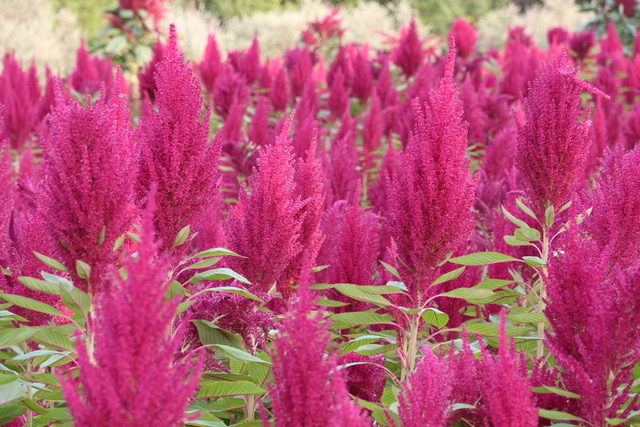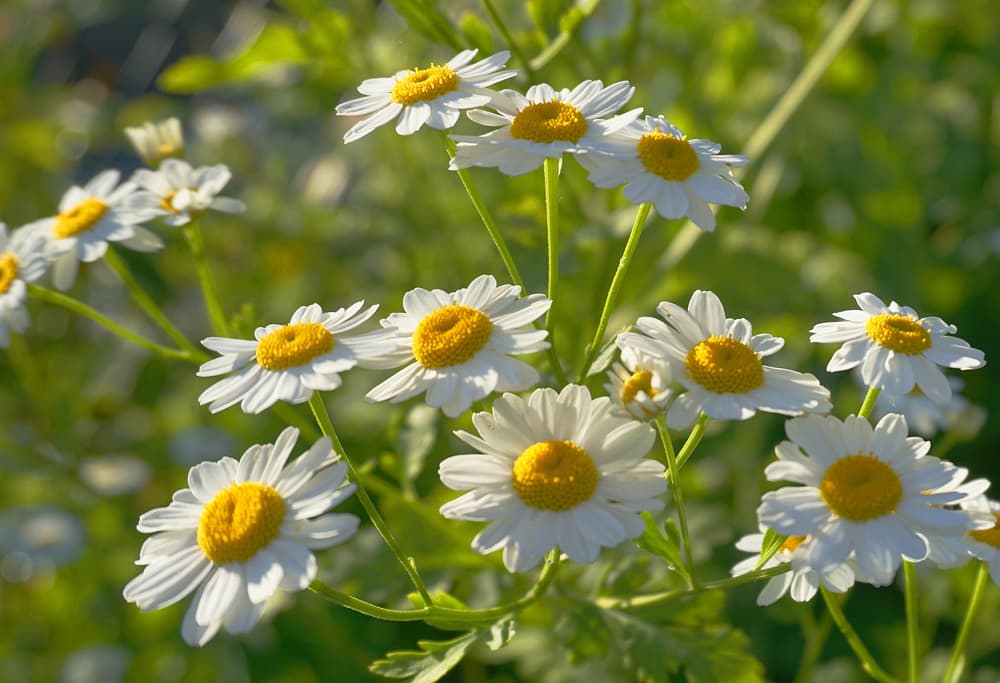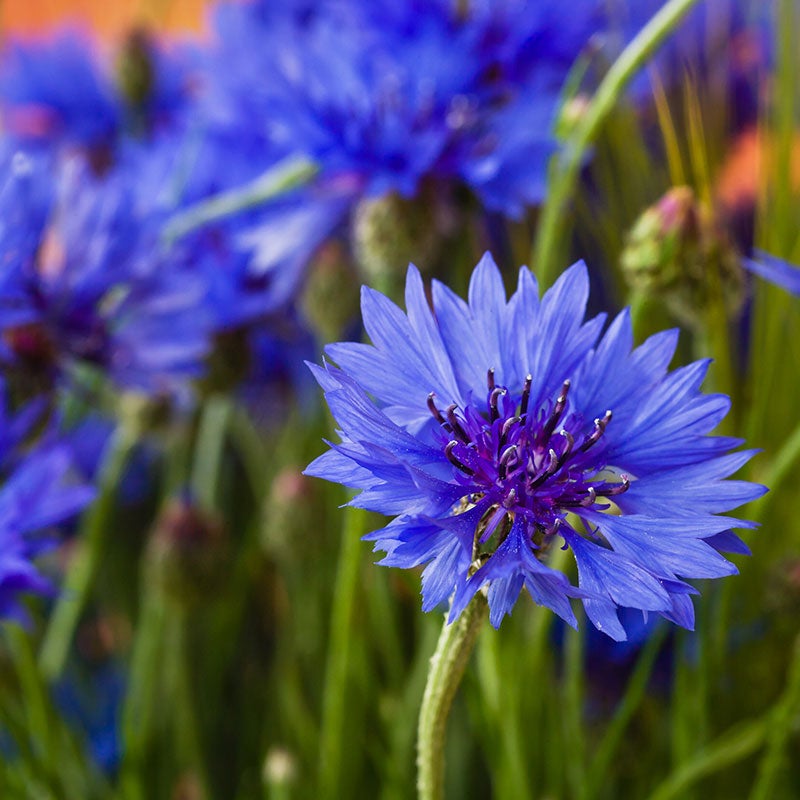
Growing Guide for Amaranth
“Amaranth is a versatile and vibrant plant, renowned for its brightly colored flowers and nutritious seeds. It’s a popular choice in gardens for both its ornamental beauty and its edible leaves and seeds. Amaranth plants are tough and fast-growing, often reaching impressive heights, and can add a dramatic effect to your garden.” Making Garden Magic
Height: 4′ – 6′

Amaranth
Image Credit: Whole Grains Council
“In 1519, when Spanish conquistadors arrived in the Aztec empire’s capital city of Tenochtitlan, amaranth – sometimes called the “food of immortality” – was the second most important food crop in the Americas after maize. However, the Spanish invaders quickly began to restrict production of the crop in order to defeat the Aztec people and suppress their culture and traditions, and amaranth’s role supporting an empire of 5 million people began to wane. Now, many centuries later, the popularity of amaranth is on the rise again as consumer interest in ancient grains grows and farmers facing the challenges of climate change have begun seeking crops that are more resilient and adaptable.” Whole Grains Council


Angelica
Image Credit: Horticulture Magazine
Height:: 6′ – 8′
Growing Guide for Angelica
“Angelica is a striking biennial or perennial herb known for its tall, stout stems crowned by large umbels of white or greenish flowers, prized for its culinary and medicinal uses, with a distinct fragrance and a taste reminiscent of a blend between celery and anise. This architectural beauty attracts pollinators, offers edible and medicinal properties, and showcases ornamental seed heads, making it a versatile addition to gardens and herbal remedies.” Making Garden Magic


Anise Hyssop
Image Credit: American Meadows
Height: 24″ – 42″
Perennial – Native
Growing Guide for Anise Hyssop
‘Anise Hyssop, known for its aromatic leaves and attractive flowers, is a perennial herb that adds both beauty and utility to your garden. It’s loved by gardeners for its ease of care, long blooming period, and the fact that it attracts pollinators like bees and butterflies. The leaves and flowers are both edible, with a sweet, licorice-like flavor, making it a delightful addition to teas and salads.” Making Garden Magic

Bachelor Button or Cornflower
Image Credit: American Meadows
Height: 28″ – 36″
Annual
Growing Guide for Bachelor Buttons
“Bachelor’s Buttons, also known as Cornflower, are easy to grow and often used in wildflower gardens, cottage gardens, and as cut flowers. These are one of the earliest flowers to bloom and they attract many beneficial insects to the garden during a time when there’s not many other food sources.” Making Garden Magic


Wild Bergamot (Monarda fistulosa)
Image Credit: American Meadows
Height: 24 – 48″ tall
Growing Guide for Bee Balm
“Bachelor’s Buttons, also known as Cornflower, are easy to grow and often used in wildflower gardens, cottage gardens, and as cut flowers. These are one of the earliest flowers to bloom and they attract many beneficial insects to the garden during a time when there’s not many other food sources.” Making Garden Magic



Borage
Image Credit: Horticulture Magazine
Height:2′ – 3′
Growing Guide for Borage
“Borage, known for its beautiful star-shaped blue flowers and cucumber-like flavor, is a wonderful addition to any garden. It’s not only an edible herb but also a fantastic companion plant, attracting beneficial insects. Borage is known to self-seed prolifically, so once planted, it often returns year after year.” Making Garden Magic

Growing Guide for Bronze Fennel
“Bronze fennel is a beautiful plant with purplish-bronze feathery leaves. It’s is known for its leaves and seeds that are used in cooking, and it’s a favorite snack for butterflies, especially the caterpillars of swallowtail butterflies.
“Bronze fennel has a stronger flavor than regular fennel, so don’t use too much of it in your recipes!” Making Garden Magic


Butterfly Weed (Asclepias tuberosa)
Image Credit: American Meadows
Height: 24-36″ tall
Growing Guide for Butterfly Weed
“Asclepias, commonly known as milkweed, is well-known for its role in the life cycle of the monarch butterfly. “This perennial plant is not only crucial for these butterflies but also adds beauty to gardens with its attractive flowers. Asclepias varieties can vary in color and size, but all share the characteristic of providing essential habitat and food for monarch caterpillars.” Making Garden Magic

Calendula
Image Credit: American Meadows
Height: 12″ -24″ tall
Growing Guide for Calendula
“Calendula, known for its bright, cheerful flowers, is not only beautiful but also has medicinal properties. It’s an excellent choice for beginner gardeners due to its hardiness and ease of care. The petals are edible and can be used to add color to salads.” Making Garden Magic

Growing Guide
“Celosia, with its striking and colorful flowers, is a favorite for adding vibrant color to gardens and as cut flowers. These annuals are known for being easy to grow and tolerant of heat.” Making Garden Magic
:max_bytes(150000):strip_icc():format(webp)/GettyImages-528491678-ef1de09a80d943e5947a7b59298c7d21.jpg)
Getty Images
“Celosia plumosa, or plumed celosia, is known for its compact, upright feathery blooms that have a sort of flame-like appearance. This is the most popular variety, says Nicole Shah, gardening expert and co-founder of Garden Girls.” Martha Stewart
:max_bytes(150000):strip_icc():format(webp)/cockscomb-celosia-getty-0623-e7d28432a4f246fa9ce879819bf03568.jpg)
“Commonly known as cockscomb, this specific type has compressed and unusually shaped feathery blooms, says Trautz-Awot says. It has the appearance of tropical coral. The blooms often grow to be so large and heavy that they need to be staked.” Martha Stewart


Chamomile
Image Credit: Horticulture Magazine
Height: 24″
Growing Guide for Chamomile
“Chamomile, particularly German Chamomile (Matricaria chamomilla), is a beloved herb for its aromatic flowers used in teas. Chamomile is easy to grow and prefers light, well-drained soil. It also reseeds easily, making it a great self-sustaining plant in your garden.” Making Garden Magic


Eastern Red Columbine
Image Credit: American Meadows
Height: 24″ – 36″
Perennial
Cold Stratification
C Blue Columbine
Blue Columbine
Image Credit: American Meadows
Height: 24″ – 36″
Perennial
Growing Guide for Columbine
“Columbine is a perennial known for its distinctive, bell-shaped flowers. It’s a shade-tolerant plant that’s perfect for woodland gardens.” Making Garden Magic


Lance Leaf Coreopsis
Image Credit: American Meadows
Height: 24″
Annual
Coreopsis is available in several colors
Growing Guide for Coreopsis
“Coreopsis, often known as tickseed, brightens gardens with its cheerful, daisy-like flowers. These low-maintenance perennials are drought-tolerant once established, making them a great choice for sustainable gardens. Their long blooming season, from early summer to fall, provides a continual display of vibrant color and attracts beneficial pollinators.” Making Garden Magic


Cosmos
Image Credit: American Meadows
Height: 12″ – 72″
Annual
Growing Guide for Cosmos
‘Cosmos are cherished for their vibrant, daisy-like flowers and ease of growth. Cosmos thrive in poor soil and neglect; over-fertilizing or over-watering can actually reduce their bloom. Since they thrive in poor conditions and produce a lot of seeds, they can become borderline invasive without active management.” Making Garden Magic


Wizard of Oz Ball Dahlia
Image Credit: American Meadows


Delphinium Light Blue White Bee
Image Credit: American Meadows
Height: 18′ – 20″

Delphinium Blue Guardian
Image Credit: American Meadows
Height: 30′ – 40″

Delphinium Lavender Guardian
Image Credit: American Meadows
Height: 30′ – 40″
Growing Guide for Delphiniums
“Delphiniums are known for their stunning spikes of colorful flowers. They are perennials that require some care to thrive, including protection from strong winds. Delphiniums are toxic if ingested and need to be handled with care. They grow best in cooler climates and are often grown from established plants or started indoors as seedlings.” Making Garden Magic
 .
. .
.
Dianthus Sweet William
Image Credit: American Meadows
Height: 12″ – 24″
Growing Guide for Dianthus
“Sweet William is an appealing garden favorite known for its charming, fragrant blossoms.” Making Garden Magic
Discover more from Jacki Kellum
Subscribe to get the latest posts sent to your email.

